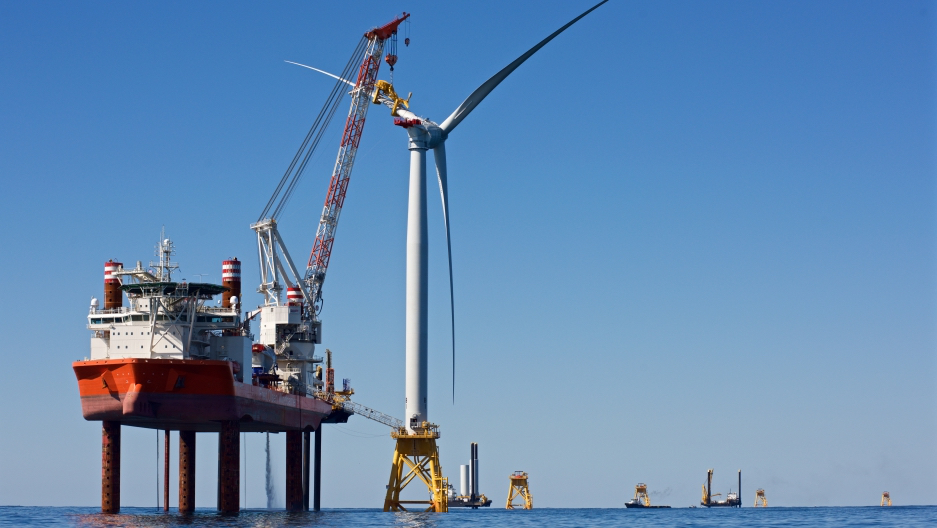As numerous offshore wind projects begin to take shape off U.S. coasts, the federal government is modifying many of its oversight policies regarding this growing renewable energy industry.
For the first time in more than a decade, the Coast Guard has revised its guidelines for reviewing the effects of offshore wind farms on commercial shipping, in recognition that such projects could significantly impact navigation safety, ship traffic routes, and the Coast Guard’s ability to respond to at-sea emergencies.
Issued last month, the new guidance outlines navigational safety information that the agency will consider when reviewing permit applications to construct and operate offshore renewable energy installations, including offshore wind farms. These guidelines replace those issued in 2007.
The Coast Guard advises the Bureau of Ocean Energy Management (BOEM), an arm of the Interior Department, on offshore leases and can recommend that project developers undertake a Navigation Safety Risk Assessment (NSRA) that evaluates marine traffic patterns and consults with a wide range of stakeholders including fishermen, recreational boaters, passenger vessel operators, tug and barge operators, large commercial vessels, pilots, port authorities, harbor safety committees, waterfront facility owners and law enforcement. This new guidance details what should be included in an NSRA.
The Coast Guard concurs that “offshore wind is a viable electricity source,” and that the U.S. has “abundant and high quality offshore wind energy resources.” But, the agency said, due to “wind farm sizes, locations and configurations, offshore wind has the potential to impact navigation safety for all users.”
As new offshore wind projects are developed, ship traffic congestion can result when vessels are redirected to smaller areas. “This increased vessel density may also cause the mixing of vessel types and speeds and also change the geometry interactions as vessels come within close range of each other,” the Coast Guard said. “These changes may increase risk of collision, loss of property, loss of life and environmental damage.”
The guidance states further that when two or more energy areas are in close proximity, project developers should consider alternative routing measures and collision avoidance technology as part of their risk assessment.
The Coast Guard said offshore wind farms could also affect the performance of electronic navigation systems used in the maritime environments, including radars and communication systems.
Additionally, the new guidance outlines new “Marine Planning Guidelines,” similar to those used in the U.K., to help set minimum safe distances in the planning of offshore wind farms that consider all sea uses. Charlie Papavivas, an attorney with Winston & Strawn in Washington, D.C., writes that Congress had considered mandating minimum safe distances in the Coast Guard Authorization Act of 2019 but the provision was dropped before the bill passed the House in July.
The nation’s first commercial wind farm began operations in 2016 off Block Island, R.I., and there are currently several other projects off the Atlantic and Pacific coasts in various stages of permitting.
NEW VISAS FOR FOREIGN OFFSHORE WIND WORKERS
The State Department has also made a regulatory change, adding a new visa category for foreign crewmembers who work on vessels involved in offshore wind operations.
The new guidance, part of the Foreign Affairs Manual, addresses regulatory roadblocks that were causing logistical problems for offshore developers due to varying ways that federal agencies were applying crewing laws and the Outer Continental Shelf Lands Act to offshore wind farms.
The OCSLA requires vessels engaged in activities in the Outer Continental Shelf to use U.S. crewmembers but allows an exemption for foreign-flag vessels engaged in OCS activities that are more than 50% foreign owned or controlled to use foreign crews. This requires an application to the Coast Guard. With an exemption letter in hand, foreign crewmembers can obtain a B-1 visa from a U.S. embassy which allows them to leave the vessel in the U.S. or travel to the U.S. to meet a vessel.
But problems have arisen because the Coast Guard won’t issue the letters for offshore wind workers because the agency says the exemptions only apply to minerals activities in the OCS, like oil and gas drilling. This has caused confusion at U.S. embassies, resulting in many visa denials for offshore wind workers.
The new guidelines correct this by allowing the issuance of a B-1 visa for foreign offshore workers without the need of a Coast Guard crewing exemption.
Blank Rome, a Washington law firm specializing in maritime affairs that worked out the compromise with federal officials, called the changes “a positive step to facilitate offshore wind projects in the United States.” The firm urged vessel owners and operators to study these changes and ensure that the new visa application procedures for their crewmembers and contractors take into account the new guidance “so that offshore wind projects can be adequately staffed without delays.”
It said that additional visa and other legal hurdles for the industry await resolution, and that given the newness of offshore wind in the U.S. and overlapping jurisdictions by federal agencies, developers should expect more regulatory issues in the future.



.JPG.small.400x400.jpg)

